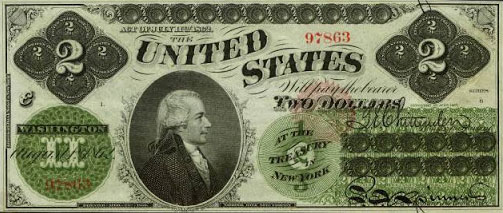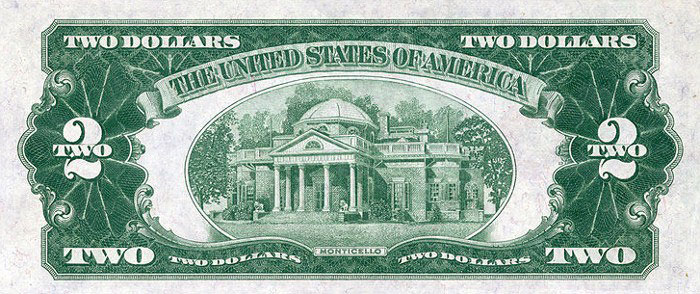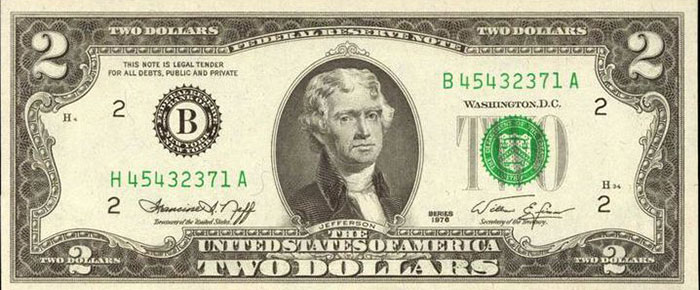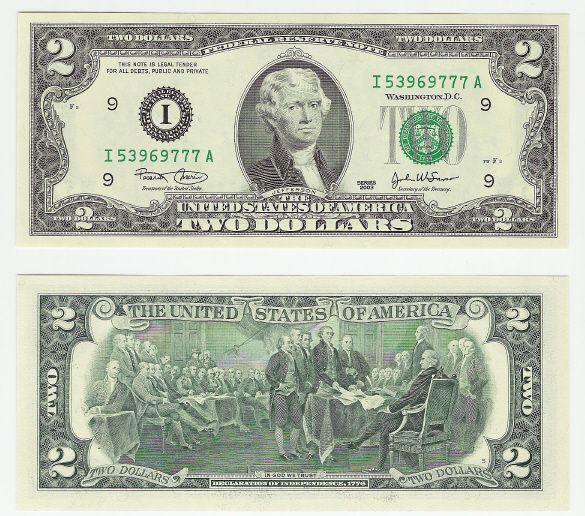The $2 bill has never been very widely accepted by the American public, nor as widely collected as other denominations
By Bullion Shark LLC ……
When the Continental Congress was considering the first federally issued money, initially it authorized bills of credit in many denominations, including $2. But only a relatively small number of said $2 notes (49,000) were authorized. The problem is that that paper currency (not only $2 bills) was backed only by the word of Congress and rapidly depreciated in value. This led them to forbid paper currency as legal tender and the issuance of only silver, copper, and gold coinage after the United States Mint began operations in 1792.
Series 1862

But during the Civil War with the federal Treasury Department on the verge of bankruptcy, Treasury Secretary Salmon Chase proposed issuing legal tender notes to aid the Union’s financial situation. Those first $2 notes from 1862, which measured 7.375 inches by 3.125 inches featured an engraving of Alexander Hamilton on the faceplate and ornate scrolls with “2” on the backplate.
But it took some time for paper currency to catch on because of the widespread preference for hard currency, and banks at the time issued their own paper bills, too. Those large bills did not circulate very widely at the time partly because the average person earned less than a dollar a day, but then inflation eroded the value of the dollar, which increased their usage.
Series 1928

Other large-size “deuces”, as $2 bills are sometimes called, were also issued and, starting with Series 1874, Hamilton was replaced by Thomas Jefferson, who is still on the bills today that are for this reason also known as “Toms”.
In 1928 the size was reduced to 6.14 inches by 2.6 inches, and starting with Series 1928 the backplate featured Monticello, Jefferson’s home. Until 1965, $2 notes always carried a red seal, but since then they have carried a green seal. In addition, there are scarce blue seal $2 bills from the Series 1918, which are worth from $350 in worn condition to thousands in uncirculated state.
By the time of the Great Depression when money was scarce, $2 bills began to be associated with superstition and also with bribery and other criminal activities. They were used by Tammany Hall (the 19th-century Democratic Party political machine in New York City) to bribe immigrants for votes as well as in gambling and prostitution (at the time, $2 was a popular increment for such activities).
This reputation certainly did not help the circulation of the bills, which were actually very cost-efficient for the government since it could make half as many as $1 bills and they lasted much longer (about six years as opposed to 18 months for $1 notes). People were also more likely to hoard than spend them and use them for tips or as gifts.
By the early 1960s, the $2 bill rarely circulated, and in 1966 it was officially discontinued because of low public demand. Overall, from its inception in 1862 until the 1965 bills were printed, a total of 1.6 billion were printed.
Series 1953

This series saw the red seals on earlier $2 bills moved from the right side to the left side of the bills. Some Series 1953 $2 bills are scarce, such as 1953-C * bills since only 360,000 were made and uncirculated examples are worth about $100.
If a $2 bill has a star next to its serial number, that means it is a Star Replacement Note, which is scarce, and even circulated examples are worth from $5 to $50.
These notes have been printed since 1910 to replace misprinted or otherwise faulty notes, and the use of the star and a unique serial number helps the government keep track of how many bills are out there. The number of star notes is much smaller than regular notes, which is why they are very collectible.
Series 1976

In 1969, then-Director of the Bureau of Printing and Engraving James Conlon suggested reissuing the bills as a cost-saving device. In 1970, a commission studying how to commemorate the upcoming Bicentennial of the United States in 1976 with coins and medals proposed issuing a $2 bill with a special design for the event.
In 1974, Congressional legislation was introduced to print $2 Federal Reserve notes with a design emblematic of the bicentennial of the American Revolution on the reverse, and one chosen by the Treasury Secretary on the obverse. The Federal Reserve commissioned a study that founded that while there was no latent demand for the $2 bill, the public would use them if the bill was issued in large quantities.
On April 13, 1976, Jefferson’s 233rd birthday, the reissuance of the $2 was effective and featured an obverse with a portrait of Jefferson based on a painting by Gilbert Stuart, and a reverse with a scene from the signing of the Declaration of Independence based on an 1818 painting by John Trumball.
Jefferson remains the only person to appear on both sides of U.S. paper currency.
How Much Are $2 Bills Worth?

$2 notes from Series 1976, 1995, 2003, 2003A, 2009, and 2013 still circulate. In circulated condition they are only worth face value, while in nice uncirculated condition are worth $5-10.
The Series 1928 notes command $60 circulated and $100 uncirculated, while Series 1953 are worth $10 and $25 respectively. Series 1963 is worth about the same as 1953 notes.
A collection of each of these types is not hard to obtain (except for the star notes).
The larger size bills issued prior to 1928 are very collectible and even if very worn are worth $100. Uncirculated examples command from $500 to tens of thousands and should be professionally evaluated and graded by a service such as those offered by PMG, which is a currency-grading service affiliated with NGC.
Collecting $2 bills can be a rewarding experience since many of them were printed in much smaller numbers than other paper currency and because of the unique history behind it.
* * *





I want to buy $ 2bills from 1862
Perhaps the Treasury should consider:
• Redesigning the “deuce” as part of the finally-resumed updates to higher denominations
• Stepping up production
• Eliminating once and for all the wasteful $1 note
Such a program would short-circuit (admittedly valid) objections to carrying multiple dollar coins while at the same time making a significant dent in the BEP’s printing costs. Making change would never require more than a single coin or at most a pair of $2 bills. People wedded to their “folding money” would still have plenty of twos to carry, while the two would simply replace the one in cast drawers.
Doing away with the one$bill will in a short time, stores will stop selling everyday needs for a dollar. Now the economy will hurt with higher prices.If you dont believe where is the penny pieces of gum., the nickel candybar. Those were mainstay coins used 100 years ago. Most are in piggy banks today
Penny gum and nickel candy bars vanished long before any coin denominations were changed. They lasted until the 1950s, when we were using the same range of coins and bills that we had in the 1930s. They went to the same place as 25¢ gasoline, 50¢ hamburgers, and $2000 cars. After all, did prices drop in the 1970s when people started using multiple quarters instead of half dollars?
Lazy Deuce ! Check ‘em out!
So how much would a sheet of uncirculated, uncut, minted, $2 bills be worth 2003 editions
An 1861 confederate state half daller how much are they worth silver confederate state money marked 1861 issued
Only a small number of genuine Confederate half dollars (note spelling) were made, along with a larger number of restrikes. However there are many counterfeits as well as legitimate replicas. The latter will have the word COPY visible in the design.
If your coin _doesn’t_ have the word COPY on it, you should have it examined by a professional. There’s no way to evaluate it from a description, unfortunately.
Do u hve any ideal, how much 1 is worth it’s 2021 now. An it was published in the 1800 s it’s close too 200 years old.how much wld a person get out of 1 of these coins.
? More info’s needed. You’re asking about coins but the story’s about bills. In any case at a minimum you need to specify its design, its date if available, and its condition. If you have a bill dating from the 19th or early 20th centuries you’d almost certainly be better off having it examined in person by an expert because there can be additional factors involved.
Also, to explain terminology, bills are simply said to be “printed” rather than “published”. Hope this helps.
What about mule notes, are they worth collecting. I haven’t heard anyone talking about these in quite some time.
Tengo uno de 1976
El valor es solo $2
What about a $2 bill 1976 red marking and a red man in top hat and tails with a cane stamped on it
I have 1976 $2 bill with the post office stamp .If interested make me a offer
Tengo 23 billetes de 2dls del año 1976 y 57 de 2dls de diferentes años
I like you, Clockwork Squirrel. You’re smart, but you don’t boast it.
My Mom has two, uncirculated $2 bills her Father gave her many years ago before he passed away, sometime before 1956 when she was 9 or 10 years old. She won’t let me see them yet though.
My Mom is a very smart woman, as well…!